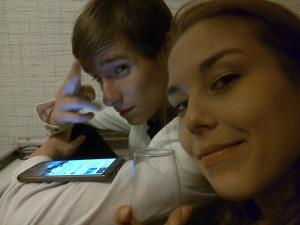 together/alone – Searching for a Soulmate in Summer Prague
together/alone – Searching for a Soulmate in Summer Prague

spolu/sami (in English: together/alone) was a game about ordinary people in present-day Prague. The larp was lyric, melancholic, atmospheric, and authentic. It was about friendship, love, life, and things that really matter. The characters were asking themselves “Can we be happy when we find our soulmate?” The game was created through workshops during one weekend and played on the following weekend. It used the whole city as a scene – streets, parks, cafés, and flats. The game had neither a main plot, nor events common for all characters, except for the ending location. We gave players guidance through the workshops, a theme, structure, and most importantly the feeling of the game.
There is an English version of the Design Document and a Workshop manual published with this article. That is everything you need to run the larp and we will be truly pleased if you use them. And even happier if you let us know about it. Please keep the difference between Czech play culture and yours in mind and adapt the materials accordingly.
This article was initially published at Nordic Larp: https://nordiclarp.org/2017/03/27/togetheralone-searching-for-a-soulmate-in-summer-prague
Collective Creation
The decision to create the game through workshops was based on several reasons. Firstly, we wanted players to play the characters as everyday people in everyday situations. It is easier to do this with close-to-home characters created by the players themselves to suit them. Secondly, we were aiming at authenticity. We supported players in including their experiences into their own characters or inspiring other players. Also, as the game mechanics were rather hardcore, it was important for the players to meet each other before the game. This gave them the opportunity to design the relationships of their characters with respect to the other players and their personal sympathy.
Saša’s last text message to Pavel after he broke up with her. She pushed his hand off when he tried to hug her on their last meeting.
“I don’t remember when you hugged me last time. I would like to remember it.”
It was important to us to ensure that the players would leave the workshops with a clear picture of their characters, relationships, and plots . Therefore we prepared the Book which contained worksheets for a number of workshop exercises. It helped players to note, concretize, and stabilize their ideas. The game on the second weekend was played completely in-character. No further metagame communication, except of safety techniques, was allowed.
Everyday Play
We believe that the designers should not only give content to the players (it doesn’t matter if they create it directly or provide tools for its creation), but they should also tell them how to play the game. A few words of instructions are able to change a larp entirely. Just imagine what would happen with the last game you have played, if the author told the players before it started “It is a comedy larp. Play it that way.”
We went even further in spolu/sami. We instructed players not only how to play the game but also how to act within it. We used a concept of everyday play which perfectly suits the vision of this particular larp. We believe that everyday play brings both esthetical and functional quality. It is challenging for players in all forms: as actors, as creators, and as spectators. As actors they are asked for subtle, natural, detailed acting (high resolution). Everyday play leads players to use all existing means of expression. As creators they have to work out how to portray characters and their stories in hints only. The aim was to avoid literality. The players were continuously deciding what to say and what should stay untold. The things you don’t say are often more important than what you do say. As spectators they need to read between lines and to interpret the behavior of other players.

We believe that everyday play looks more authentic and it supports immersion of players. The game itself is set in an absolutely authentic setting. Almost everything could be (and should be) interpreted within the game. We believe that the most vulnerable place which may break a player’s immersion is interaction with another player, in this particular game. And everyday play makes the interface between the game and the reality as seamless as possible.
Of course, there are limitations connected to this approach. The player is able to play only things which he is able to portray authentically. The player can’t fake a cry – a fake cry is still a fake cry in the game reality. And we put further limitations within the game ourselves because of safety (intimacy techniques) or playability (key partner rule).
Freedom
The players alone were responsible for the believability and consistency of the characters. We emphasize the freedom of creation and possibility to change any aspect of the character anytime. As mentioned above, the players created the character, its development or meetings with other characters, in workshops. But everything could be changed to better suit the actual situation within the game. If anything pre-agreed didn’t make sense, the player could simply leave it out or alternate it.
Everything that the co-players do during the second weekend is interpreted as an action of the character, not the player. If a player didn’t come to a pre-agreed meeting, the character is blamed, not the player. The co-player may send them an angry text message or call another character worrying about them. Everything what happened or did not happen affects the game that follows.
Night talks on Messenger with a friend.
Šimon: Well, I have been on a night walk with Saša. Do you know her?
and and
well
I kind of ran away, you know
I mean
I am really attracted to her
but I can’t do that because of Nikola
but Nikola is supposed to be home like now
and she still didn’t come
(…)
Alžběta: Well, Nikola was sitting in the subway next to Karel and it seemed to me that the party was just about to begin.
(…)
Alžběta: Are you okay? You say that you are okay at first but you are silent now and that’s not a good sign.
She went for a drink with him and she pulled out a bottle of wine, I don’t think that she is cheating on you
But I know it still can make you miserable”
Internal Conflict and Key Partner
It is easy to get lost in such large creative freedom. Therefore, we provided the players with a clear guide and game development structure. We set the main topic of the game: “Can we be happy when we find our soulmate?” Based on the topic, each player set an internal conflict of the character, which we called the Problem. The Problem affects the character in everyday life, no matter if they know about it or not. It was crucial that the conflict was truly internal and independent of external impulses. We wanted characters to struggle with themselves, not with each other or the game.
The manifestations and changes of the Problem were prepared by the players during the workshop weekend as well. The changes of the Problem were shown (directly or indirectly) in interaction with the Key Partner. The rule of the Key Partner was the only concession we made on players’ freedom. The game was so fluid that we worried about its playability. We wanted to avoid a situation in which the player is not able to play the game. Or more precisely, a situation in which there is nobody to play the game with. Therefore, each player chose one Key Partner who had to follow their crucial pre-game agreements and meetings. The rule enabled playing the game in rough contours even if everything else were to go wrong.
Facebook Interlude
The players created a closed Facebook network with their characters and relationships, between the first and the second weekend. They were asked to set up the character’s profile, the character’s key life moments, and write at least one post every day. They could also comment on the posts of their in-game friends. All Facebook communication was in-game as well.
Our goal was to bridge the gap between weekends and give the players a reason to think about the character every day. It worked great. The in-game digital microcosmos was quickly established. It allowed players to internalise who is who, how they behave, and who knows whom. Facebook was used during the second weekend for in-game communication as well. Unexpectedly, it also became the most important source of information about the game for us, the organizers.
Intimacy

Intimacy is an inseparable part of the vast majority of romantic relationships. We knew that it would be an important part of the game. We had done a lot of research about intimacy mechanics before the game. The authenticity of the larp brought us naturally to the option with minimum simulation techniques. The majority of intimate expressions were used as they are. A kiss was a kiss and a French kiss was a French kiss. We introduced a technique for simulation of sex which was a French kiss in a situation where the partners are shirtless (corsets, bras and similar stay on). The players’ safety and comfort was crucial for us. And because the mechanics were rather hardcore we set several safety rules.
Safety Mechanics
We distinguished four intimacy levels: kiss on the cheek (starting level), kiss on the lips, French kiss and sex. If players wanted to move up a level, they asked a partner for permission by double-tapping them with a hand. If the partner agreed, they responded by another double-tap. It was necessary to get this agreement for every increase of intimacy level, and separately for every intimate contact.
The players registered themselves in groups of four. This rule should ensure that everybody had co-players with whom are ok to play the mechanics. As the relationships were created in the workshops, the players could easily chose what they will play with whom. Of course, the players had to discuss their personal intimacy levels and preferences: and they were able to lower the intimacy mechanics’ levels.
However, it was forbidden to raise the level of intimacy. We have strictly forbidden real sex during the game even between real off-game partners. The rule should prevent the hypothetical situation when the game partner believes that manifestations of affection are real and they would want more. The no sex rule is clearly saying that such behavior cannot be considered as a part of the game (it is out of the magic circle) and it has to be stopped. Last but not least, the Cut safety rule could be used.
Based on the after-game questionnaire, we can say that the intimacy mechanics worked quite well. A number of players appreciated the possibility to agree on other than the default mechanics with a specific partner. In several cases players didn’t need to use any mechanics in the game. At least three players used the sex mechanic as it was designed and they were happy with it. Several players mentioned that they stopped using the double-tap rule during the game with a specific partner. But they used it again if they played intimacy with another player.
Thank you. It makes sense.
Argument on Messenger, after a live argument.
Šimon: dead phone, it was ringing when I called at half past two
I wish you wouldn’t pull the wool over my eyes
Nikola: And if I told you that I just wanted to be switched off? Would it be better for you?
Šimon: and you just want to be switched off?
just go away at night
without me
Aftermath
If you are interested in a player’s view on spolu/sami, you can check the review by Jakub Balhar.
We are thrilled that Rolling will use the adapted workshops of the larp for Zusammen/ Sami/ Sudetenland.
spolu/sami (together/alone)
Authors: Kamil Buchtík, Lucka Chlumská
Translation: Zevla Zevlová, Kamil Buchtík and others
Proofreading: Crian Shields
Date: first run June 11-12 and 17-18, 2016
Location: Prague, Czech Republic
Length: 27 hours 1st and 25 hours 2nd weekend
Players: designed for 16 to 36 players, played by 21 players
Budget: CZK 6,300 (EUR 230)
Participation Fee: CZK 300 (EUR 11)
Website: http://spolusami.larpy.cz
Ludography
Kamil Bartczak and Aleksandra Ososińska, On the Road (Poland: 2015).
Tue Beck Saarie and Jasper Bruun, In Fair Verona (Denmark: 2010).
Mikuláš Bryan, Kateřina Holendová, and Monika Kadaňková, et al., Dance Macabre (Czech Republic: 2012).
David František Wagner, Lucie Chlumská, and Severin Rast, et al., Zusammen/ Sami/ Sudetenland (Czech Republic, Germany: 2017).
Jesper Heebøll-Christensen, Elisabeth Nørresø Haase, and Sanne Harder, Agerlund (Denmark: 2009).
Peter Schønnemann Andreasen, Kristoffer Thurøe, and Mathias Kromann, et al., Totem (Denmark: 2007).
Cover photo: together/alone (promo photo by Hana Maturová)
Zanechte komentář
Nejčastější štítky
- Court of Moravia fantasy Jihomoravský kraj komorní metodika městský outdoor Pardubický kraj Prague by Night Praha
- Všechny štítky
Archivy
- Říjen 2023 (1)
- Červen 2023 (2)
- Květen 2023 (1)
- Únor 2023 (1)
- Leden 2023 (2)
- Prosinec 2022 (2)